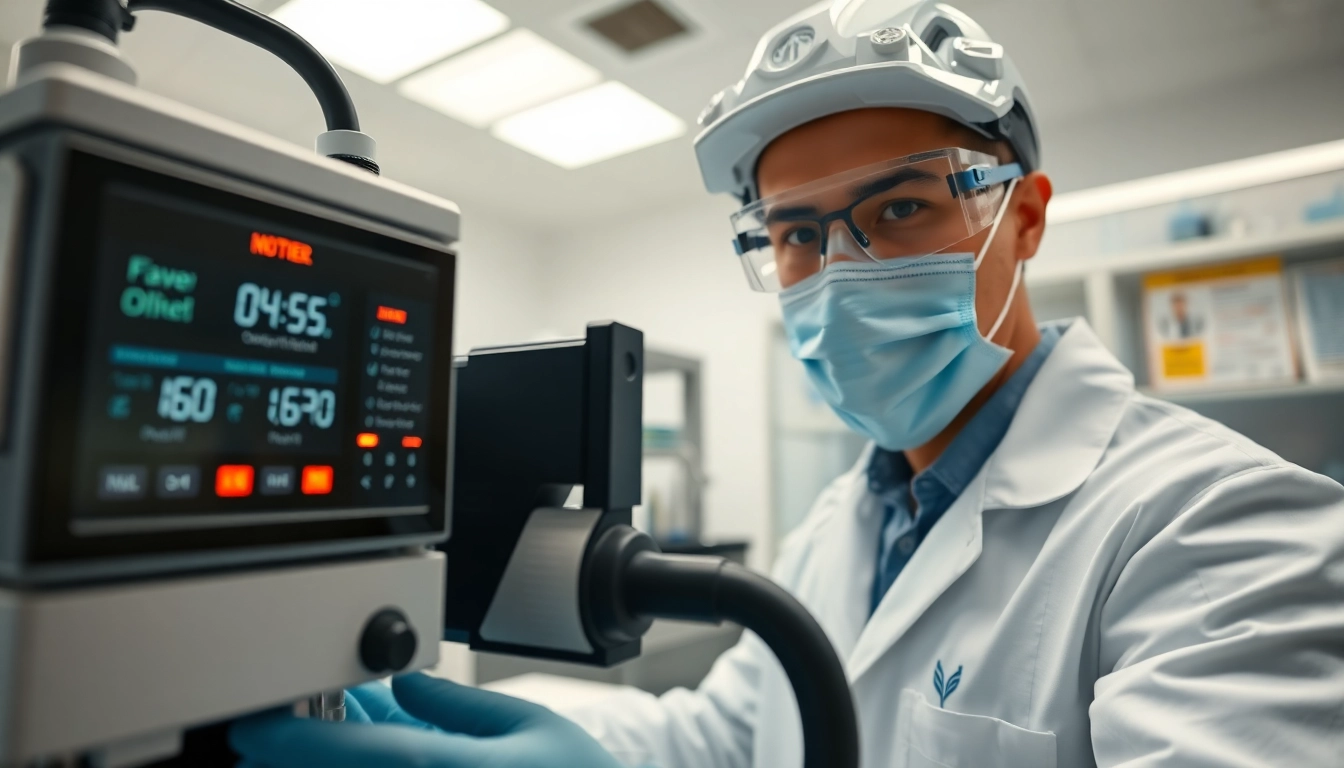Understanding Hydrogen Cyanide: Properties and Risks
1.1 Chemical Properties of Hydrogen Cyanide
Hydrogen Cyanide (HCN), also known as prussic acid, is a highly toxic chemical compound with the molecular formula HCN. It is a colorless gas or a liquid at room temperature and possesses a faint, bitter almond odor. HCN is highly soluble in water, making it a dangerous contaminant in industrial applications where it may come into contact with water sources. Safety data sheets consistently highlight its potential to react with oxidizing agents, which can lead to dangerous conditions if appropriate precautions are not taken. Understanding these properties is crucial for anyone involved in environments where this compound is present to ensure effective Hydrogen Cyanide detection and management.
1.2 Health Risks Associated with Hydrogen Cyanide Exposure
The health risks linked to hydrogen cyanide exposure are severe and can be immediate and life-threatening. HCN is known to inhibit cellular respiration by disrupting the electron transport chain, leading to rapid asphyxiation at a cellular level. Symptoms of exposure can range from headache, dizziness, and nausea to loss of consciousness and, in extreme cases, death. Long-term exposure can result in chronic health issues like neurological damage. It is critical for workers in various industries, including mining, manufacturing, and agriculture, to recognize these risks and engage in preventive measures.
1.3 Regulatory Standards for Hydrogen Cyanide Detection
Given its hazardous nature, hydrogen cyanide is subject to various regulatory standards. In the U.S., the Occupational Safety and Health Administration (OSHA) has established permissible exposure limits (PELs) for HCN in the workplace. The American Conference of Governmental and Industrial Hygienists (ACGIH) has also deemed HCN a significant health risk, recommending Threshold Limit Values (TLVs) that inform safe exposure levels. Various international bodies, like the World Health Organization (WHO), have developed guidelines around HCN exposure limits, emphasizing the need for effective detection and monitoring systems across industries that might encounter this toxic agent.
Methods of Hydrogen Cyanide Detection
2.1 Overview of Detection Techniques
Detecting hydrogen cyanide reliably is essential for ensuring workplace safety. Numerous detection techniques are available, including electrochemical sensors, colorimetric detection, and infrared absorption methods. Electrochemical sensors offer a direct measurement approach, providing immediate feedback and are often used in portable devices for personal monitoring. Colorimetric methods involve the reaction of HCN with specific reagents to produce a color change, indicating the presence of the compound. Infrared absorption techniques measure the spectrum of light absorbed by HCN, allowing for sensitive detection at low concentrations.
2.2 Comparative Analysis of Detection Technologies
The comparative analysis of hydrogen cyanide detection technologies reveals several pros and cons for each. Electrochemical sensors are typically sensitive and easy to use; however, they can suffer from cross-sensitivity to other gases. Colorimetric methods, while simple and cost-effective, may not offer real-time results and could be influenced by environmental factors. Infrared detection is highly accurate but generally more expensive and may require more maintenance. Organizations must choose based on specific needs, taking into account factors like required sensitivity, real-time monitoring capability, and budget constraints.
2.3 Best Practices for Implementing Detection Solutions
Implementing effective hydrogen cyanide detection solutions requires adherence to several best practices. Firstly, proper placement of sensors is vital; they should be situated at potential leak sources and in areas of high foot traffic. Regular calibration and maintenance of detection equipment ensure optimal performance and accuracy. Additionally, integrating detection systems with alarm mechanisms can provide immediate warnings to employees regarding hazardous conditions, allowing for swift action. Training workers on the importance of HCN detection and proper responses during alarms can further enhance safety measures.
Choosing the Right Equipment for Hydrogen Cyanide Detection
3.1 Features to Consider in Detection Equipment
When selecting hydrogen cyanide detection equipment, several essential features should be considered. Sensitivity is a primary factor, with the ability to detect HCN at low concentration levels ensuring safety in various environments. Equipment should also be user-friendly, enabling easy operation for personnel at all experience levels. Calibration frequency and battery life are crucial, as regular maintenance is necessary for reliable results. Additionally, durability and resistance to environmental factors such as humidity, temperature, and dust are vital for equipment longevity and sustained performance.
3.2 Top Brands and Products in the Market
Prominent brands offering hydrogen cyanide detection solutions include Dräger, Industrial Scientific, and Miran. Dräger offers the X-am series of multi-gas detectors known for their reliability and user-friendly interfaces. Industrial Scientific’s iNet® platform provides real-time monitoring capabilities, which can enhance safety and compliance. The Miran series utilizes advanced infrared technology for effective detection, making it suitable for both mobile and fixed applications. Evaluating product reviews and specifications can help organizations select the right detectors that meet their environmental needs.
3.3 Cost Considerations and Budgeting
Budgeting for hydrogen cyanide detection solutions must take into account the initial purchase costs as well as long-term maintenance and operational expenses. While investing in high-quality detection equipment may require a sizeable outlay upfront, the return on investment through enhanced worker safety and compliance with regulations can justify these costs. It is wise to consider factors such as warranty, customer service support, and the potential need for training in the budgeting process. Companies should conduct a total cost of ownership analysis to ensure they are prepared for all associated expenses.
Safety Protocols in Handling Hydrogen Cyanide
4.1 Personal Protective Equipment (PPE) Guidelines
Personal Protective Equipment (PPE) is crucial in environments where hydrogen cyanide may be present. Recommended PPE includes respirators rated for HCN, gloves, and protective clothing to prevent skin contact. Workers should also be trained on the proper use and limitations of PPE in HCN exposure scenarios. Regular inspections of PPE and conducting fit tests for respiratory equipment can further enhance worker safety, reducing risk during exposure events.
4.2 Emergency Response Plans
Organizations must develop comprehensive emergency response plans for incidents involving hydrogen cyanide. These plans should include immediate evacuation procedures, communication protocols to alert authorities, and medical response procedures for potential exposure. Regular drills and training sessions can test the effectiveness of these plans, ensuring that all employees know their roles during emergencies. Documentation of incidents and responses can help refine these plans over time, contributing to a safer workplace.
4.3 Training and Awareness Programs for Workers
Training and awareness programs for workers handling hydrogen cyanide should encompass several key components. Employees must understand the properties and risks of HCN, recognizing signs of exposure and understanding the detection systems in place. Training should also include emergency response drills, instruction on the use of PPE, and regular updates on regulations and safety protocols. Implementing a culture of safety-consciousness encourages proactive behavior, leading to reduced risks and enhanced workplace safety.
Future Trends in Hydrogen Cyanide Detection Technology
5.1 Innovations on the Horizon
The future of hydrogen cyanide detection technology holds promising innovations, notably in the realm of sensor technology. The advent of nanomaterials and new chemical compounds holds potential for developing more sensitive and rapid detection methods. Innovations in data analytics, such as predictive modeling and machine learning, are also expected to improve the accuracy of detection while minimizing false alarms.
5.2 The Role of Remote Monitoring in Detection
Remote monitoring technologies are on the rise, providing real-time data to organizations regarding HCN levels within various environments. These systems can alert personnel instantly, allowing for timely evacuation and response to leaks. Furthermore, remote capabilities facilitate better compliance with health and safety regulations by enabling consistent oversight without necessitating an on-site presence, streamlining workplace safety management.
5.3 Integrating AI for Enhanced Detection Capabilities
Artificial Intelligence (AI) offers significant potential for enhancing hydrogen cyanide detection capabilities. Implementing AI algorithms can support better data analysis from detection systems, identifying patterns that may indicate leaks or unsafe conditions before they escalate. Integrating AI with existing detection technologies can streamline operations and improve safety outcomes by fostering proactive safety measures based on historical data.



